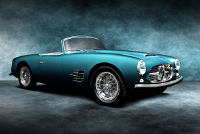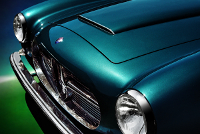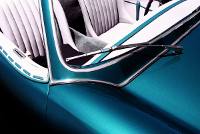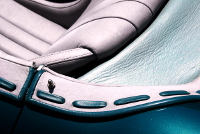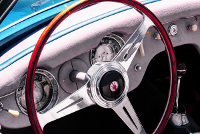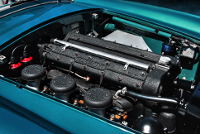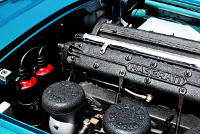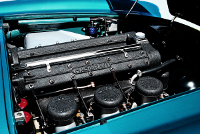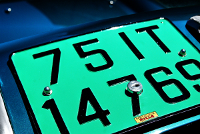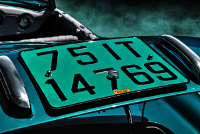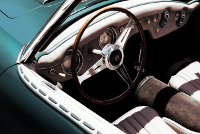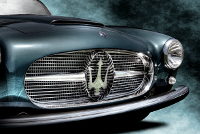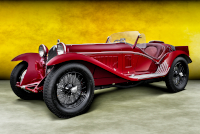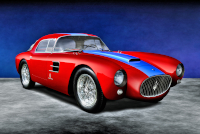Location:
Elegance at Hershey, 2014
Owner: Oscar Davis (late) | Elizabeth, New Jersey
Prologue:
Note, #2101 has since passed to subsequent owners.
Maserati often remind us of the hidden edict of classic cars: Everything is rare. Even compared to their Modenese brethren, Maserati produced cars in such low number, of such variety, and with such compulsive detail that each piece is a gem.
This Maserati is particularly unusual. For their clientele, Zagato craft lightweight berlinetta coachwork aimed at the sports enthusiast. But with the first A6G/54 set aside for their production, the result is an open roadster intended for the 1955 Geneva Salon International de l'Auto. With no top, a suede interior, and a few unusual styling cues, #2101 is a red herring. The car makes a strange statement, as if to say, "Look at what Zagato can produce; we will not make any more of these."
All of the following 20 A6G/54s bodied by Zagato are berlinetta cars in the carrozzeria's typical lightweight fashion. Maserati customers who want an open car will instead find Frua's cabriolet and spider most delectable. Unless the customer is Juan Domingo Perón, President of Argentina. In this case, Perón buys #2101 from Zagato, but requests they make a few tasteful modifications. Soon replaced by a military junta and forced into exile, Perón never receives the Maserati, and so his involvement actually shapes the car but not its history.
Also poignant is the restoration undertaken by Angelo Ferro of San Rafael, California, who founded Genoa Racing in 1979, the same year he acquired this Maserati A6G/54. Genoa Racing will transition from the SCCA Can-Am Challenge to the PPG and IRL Indy Lights Championship, along the way picking up enough experience and kit to restore the Maserati at the turn of the century.
Here, we take a proper look at the history. And in conjunction with a full overhaul of the specifics, I've refinished the main quarter shot to provide better visual support. Our image stock is old, but as always, it is a privilege to have seen the car in the flesh, and doubly so to bother over discussing its significance.
- - - - - - - - - -
► Image Source: Nikon D200 (10.2 MP)
References:
- Cancellieri, Gianni; Dal Monte, Luca; De Agostini, Cesare; Ramaciotti, Lorenzo. (English translation by Neil Davenport and Robert Newman.) "Maserati, A Century of History: The Official Book" Giorgio Nada Editore, Vimodrone, Milano, Italia. 2013, page 117-118
- Crump, Richard; de la Rive Box, Rob. "Maserati Sports, Racing and GT Cars from 1926" Third Edition, G.T. Foulis & Company for Haynes Publishing Group PLC, Somerset, England. 1992, page 134, 143
- RM Sotheby's: The auction profile from Monterey 2022, very well done with a very nice gallery.
- RM Sotheby's: The auction profile from 2013, at the time photographed by Michael Furman.
- UltimateCarPage: A dedicated profie of chassis #2101, by Wouter Melissen, October 30, 2013.
- Wikipedia: Information about Juan Domingo Perón, including the IAME Justicialista.
- Marin Independent Journal: "Marin motor sports: San Rafael’s Ferro keeps eye on open-wheel merger," by Derek Wilson, originally published March 7, 2008
The A6 marks the transition point between Maserati's strict, racing-focused past and its road car future. Powered by a 2-litre inline 6-cylinder motor, Maserati developed the unit for Formula Two competition, which in turn became a winning proposition in sports car racing with the A6GCS/53. In this respect, the A6 is counterpoint to the Ferrari 500—a model also powered by a motor developed for Formula Two racing, built into a series of berlinetta and spider-bodied sports cars.
The A6G/54 updates the 2000 GT of 1950, and in this respect could also be called a '2000 GT A6G/54.' Maserati contract Allemano, Frua, and Zagato to prepare coachwork on four primary styles. Allemano create a sultry 2+2 coupe that foreshadows trends in three-box glasshouse architecture, particularly the 3500 GT that Touring designs in 1957. Frua create rather astonishingly beautiful berlinetta and cabriolet cars, both of which make good use of two-tone liveries. And, much as they do for Alfa Romeo, Zagato create lightweight berlinetta cars of a more sporting character.
Chassis #2101 is therefore a rare gem in that it is an open Zagato car—the only open Maserati A6 Zagato, and one of very few open cars Zagato designed in the 1950s. Not simply a roadster, Zagato outfit #2101 with a refined cockpit and send the car to the 1955 Geneva Salon.
Juan Domingo Perón, the Maserati A6G/54 Zagato, and Argentine Industry
At the 1955 Geneva Salon, Argentine President Juan Domingo Perón requests that he purchase the car. First, however, Perón sends the car back to Zagato for a few cosmetic changes; these include a new windscreen, new grille, and new bonnet scoop. RM state that the color also changed from its original grigio piombo (lead grey) to the metallic aquamarine depicted here.
Now prepared to the president's liking, this A6G/54 fails to make the trip to South America owing to a coup d'état in September of 1955 that sends Perón and his wife, Eva Duarte ("Evita"), into exile. This is the period of Argentine history known as the Revolución Libertadora. Upon assumption of power, the new regime excoriates Perón for his indulgence in luxury items, and whether it is a crucial point or not, this Maserati never has the opportunity to become evidence.
Perón is a political figure of controversy, and in this summary of a mere automotive bauble, I shouldn't adjudicate his value as a person or as a customer of Zagato. Perhaps what is interesting is that Perón takes influence from Continental European culture and politics, which in turn becomes the basis for discussions of whether or not Perónism is indeed a fascist movement. But his politics seem earnest in strengthening the working class, building Argentina into a thriving economic power, and through Evita's support, securing equality for women. If only in the best light, Perón could be seen as using Italian and German fascist influence as a basis for economic policy, but crucially, not for social reform. For his controversial, if pragmatic methods, Perón's influence on Argentina remains profound, as does the animosity of his detractors.
More to our automotive concerns, consistent with his support for Argentine athletes, Perón funds Juan Manuel Fangio's Formula One campaign in Europe. It could be fair to say that without Perón's interest in growing Argentina's notoreity on the international sporting stage, the racing world would not know of El Maestro.
Moreover, at the time of Perón's interest in this Maserati A6G/54 Spider, he has created the Industrias Aeronáuticas y Mecánicas del Estado (IAME) to build the Justicialista in Córdoba. IAME operate for only two years, up to the time the military junta forces Perón into exile.
RM once wrote about the Maserati A6G/54 Spider that, "sadly, Perón was never able to take delivery, and it fell back into the hands of Carrozzeria Zagato." Perhaps the tone is a bit careless, (amended in their later material), because whether Perón deserves his indulgence in the first place, who knows what would have happened to the car in the hands of the anti-Perónists. I don't mean to suggest, never mind the fate of Argentine society, we could have lost the Maserati. But considering the desecration Perón's grave suffered upon his death over three decades later, the passion of his detractors would have certainly outweighed any trace sentimentality for a frivilous sports car in the heat of revolution.
Zagato Chassis #2101: Exportation, Angelo Ferro, and Restoration
So close to becoming part of Argentine political history, chassis #2101 leads a quiet, well cared for life in Italy. The A6G/54 returns to the Zagato stand for the 1958 Paris Salon, now brokered by Jean Thépenier, (just one year into his Parisian Maserati import business that will last until 1985). Soon after, #2101 passes into the capable hands of two Americans living abroad in France—first a diplomat, and then a lieutenant colonel of the U.S. Air Force.
With its latest American owner, the Maserati ventures stateside, travels to California, and eventually passes to Angelo Ferro in 1979. Maintained in running order for a brief spell, Ferro places the car into storage for nearly 20 years.
RM report that Ferro's intention had been to return the car to Zagato for restoration. And were he someone of lesser capital and technical means, Ferro's intentions might have led to a familiar story of the car emerging after 20 years, receiving a dust-off, and then heading to auction for another enthusiast to shoulder the burden.
Instead, Ferro has spent these 20 years building Genoa Racing, a team born from a flower market and partnered by an olive enterprise. His competition resume includes perennial open-wheel competition in the PPG and later IRL Indy Lights series, including drives that launch the careers of Jimmy Vasser and Greg Ray.
Ferro now uses his own resources to restore #2101. In this sense, his work is somewhat similar to Gordon Barrett's restoration of Alfa Romeo 8C 2300 Mille Miglia Touring Spider #2211071. Barrett had been an Indy race car builder for Grant King and A.J. Watson; he was a devoted enthusiast of Italian motorcars, and working out of his Indianapolis shop, restored #2211071 himself. Ferro does the same, only with the resources of a seasoned racing team.
From 2000 to 2003—still bearing the modifications requested by Perón in 1955—Ferro returns chassis #2101 to its 1958 Paris Salon specification (indicated by the color).
After Ferro collects the benefit of the spider's dazzle on the show circuit, in 2010 he passes the car to a British owner. By 2013, the late Oscar Davis acquires #2101, the source of our encounter, after which the car again changes hands at auction in 2022.
Motor: 1,985.6 cc straight 6-cylinder, cast-iron block and aluminum alloy head | 76.5 mm x 72 mm | 8.0:1 compression
Valvetrain: DOHC, 2 valves per cylinder, chain driven
Aspiration: triple Weber 40 DCO3 carburetors
Power: 150 bhp at 6,000 rpm
Drivetrain: 4-speed gearbox, rear-wheel drive
Front Suspension: independent wishbones with coil springs, Houdaille dampers, and anti-roll bar
Rear Suspension: live axle with coil springs, Houdaille dampers, and anti-roll bar
Architecture: steel tubular frame with aluminum coachwork by Zagato of Terrazzano di Rho, Lombardia
Kerb Weight: 840 kg (1,852 lbs)
Wheelbase: 2,550 mm (100.4 inches)
Top Speed: 210 km/h (130 mph)
Etymology:
The 'A' designation memorializes Alfieri Maserati, the firm's principal founder, a talented engineer and racing driver who died in 1932 following an accident. The firm itself was originally named Officine Alfieri Maserati when it began in Bologna in 1914. The '6' refers to the number of cylinders. The 'G' stands for 'ghisa,' or iron in Italian, denoting the cast iron block. The '/54' designation signals the ultimate development of the Formula Two racing motor that powers the A6, introduced for 1954.
Maserati also refer to the model as the 2000 A6G/54, (with or without the solidus), and '54' is itself Maserati's means of distinguishing the updated A6G car. The '2000' nomenclature underscores the motor's 2-litre capacity, and dates back to the A6 1500 of 1946. Throughout A6 development, the displacement figure may precede or follow the model designation, though Maserati appear to have reversed the position from the A6 1500 of 1946 to the 2000 GT of 1950, thus confounding two separate nomenclatures within the same lineage.
'Spider' refers to the open bodywork, itself derived from the carriage trade. Zagato craft the coachwork, and we include chassis #2101 in the title.
Figures:
A6 development begins in the late 1940s. The firm experiment with a 1.5-litre racing motor fitted to one-off spider and berlinetta cars, creating numerous gems of lightweight sports car fantasy. By 1946, Maserati attach the A6 moniker to a dedicated production run, which becomes their first road-going product.
The Barchetta registry lists 214 cars produced among all A6 models, beginning in 1946 and ending in 1957.
Zagato bodies 21 A6G/54 cars. Interestingly, #2101 is the first of those Zagato cars, and the only open-top spider. So while the car presumes to showcase Zagato's abilities at Geneva, attracting the attention of the Argentine President no less, none of the production follows suit.
Value:
Chassis #2101 sold at auction in November of 2013 for $4,455,000. In 2022, the car sold privately after RM's Monterey auction.
As befits a singular example of the Maserati A6G, this car has appeared at the world's premier concours d'elegance—St. James in England, Villa d'Este in Italy, and Pebble Beach in the United States. What then the price of art? I do feel there is a greater quality of artistry in Maserati than, say, a comparable Ferrari. The beauty the A6 platform nourishes is captivating in its diversity, carried out by so many different coachbuilders, each leaving deep impressions. Knowing the care that went into each chassis before it left the factory—the hand work, the excessive need to stamp otherwise utilitarian components with numbers and tridents, and the desire to polish and finish more surfaces than necessary—Maserati shone light on the soul of motoring, lest that passion be abused in today's commericalized versions.
Elegant Subtlety: Simple Classic Lines
The lines of chassis #2101 require a quarter perspective. In profile, there appears so little sculpture along the flanks and such slim margins over the front and rear arches that the spider loses its shape. From any other angle, however, that same simplicity of line brings subtle details to the fore. Just the gentle curves crowning the headlamps and grille are remarkable—effortless, which leaves the eyes to consume the ornate grille. And at the tail, the mild little flips of the fins are perfectly understated. The car does not slap with bravado from a distance; it draws one closer to take in the lavish passenger compartment, or perhaps to open the bonnet and discover Maserati's beautiful twin-cam Formula Two racing motor.
Juan Perón: Alterations to the Original Zagato Design
One of the more interesting features of the coachwork is that the windscreen does not use a typical chrome frame. In 1955, Perón asks for a new windscreen, so Zagato installed sturdy coachwork that frames the glass, forming a curved structure that looks as if it attaches to a hardtop. (Period photos show only a softtop in place, however.)
The seam where the windscreen frame joins the bonnet forms a deep joint below the line of the front fenders, itself trimmed in chrome. Inside the glass, a strip of metal painted to match the body courses over the top of the dashboard. This mix of chrome and painted coachwork marries the body with the cockpit, making the car look so complete that even the pedestrian wiper arms seem ornamental.
Juan Perón also requests a bonnet scoop, which in perspective provides contour to offset the clear flanks. And he asks that Zagato revise the grille. This last request removes an experimental fascia in favor of classic Maserati chrome, a loss of the avante garde in favor of tradition. But considering period photographs from Geneva, the grille change makes the car more immediately pleasant on the eye.
RM note that Perón requests that Zagato change the original grigio piombo (lead grey) paint for a metallic aquamarine termed, 'blue algido scuro,' or 'cool dark blue.' Note that RM mis-type, 'algido,' as, 'algisto.' Whether Perón requests the color himself or Zagato select the shade, the public does not see the car in this color and configuration until the Paris Salon of 1958.
Plush Compartment: Grand Touring Appointment in an Open Zagato Spider
Although chassis #2101 is an open-top roadster, Zagato furnish the cockpit in suede. Adding to the car's motor show intentions, Zagato over-stitch the door sills and finish the upholstery with teal piping and contrast stitching. The suede's main color is a strange shade of pinkish lavender, much like a faded hyacinth. Difficult to detect in sunlight, the suede pairs with the metallic aquamarine paint to transform the car into a piece of candied jewelry.
Last Updated: May 28, 2025

